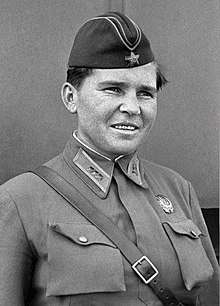Polina Osipenko
Polina Denisovna Osipenko (Russian: Полина Денисовна Осипенко, Ukrainian: Поліна Денисівна Осипенко; 8 October 1907 – 11 May 1939) was a Soviet military pilot, most notable as the co-pilot who, together with Valentina Grizodubova and Marina Raskova on September 24–25, 1938 performed a non-stop flight between Moscow and the Sea of Okhotsk, setting a new distance record for non-stop flights operated by women. For this achievement, she became a Hero of the Soviet Union, the highest military distinction in Soviet Union, on 2 November 1938. She was one of the first of three women to receive the distinction, which was awarded to her and her colleagues Valentina Grizodubova and Marina Raskova, on the same day.[2]
Polina Osipenko | |
|---|---|
 | |
| Native name | Поліна Денисівна Осипенко |
| Born | 8 October 1907 Novospasovka, Zaporizhia Oblast, Russian Empire (present-day Ukraine) |
| Died | 11 May 1939 (aged 31) Vysokoye, Rybnovsky District, Ryazan Oblast, Russian SFSR, USSR |
| Allegiance | |
| Service/ | |
| Rank | Major |
| Awards | Hero of the Soviet Union |
| Spouse(s) | Aleksandr Osipenko[1] |
Early life
Osipenko was born as Polina Dudnik in 1907 in Novospasovka, Yekaterinoslav Governorate (currently Zaporizhia Oblast of Ukraine) to a Ukrainian peasant family and the ninth child born to her family. She worked at a collective farm until leaving for flight school in 1930. Between 1930 and 1933, Osipenko was a student at the Kazan Flight School.[3]
Aviation career
After graduating from flight school she subsequently served as military officer, flying a fighter. In 1937, she set three world records for altitude.[3] In October 1937, Osipenko and Raskova set the women's flight distance record by flying from Moscow to Aktobe (1,444.722 kilometres (897.709 mi)), and in July 1938, Osipenko, Vera Lomako, and Raskova set a new record by flying non-stop from Sevastopol to Arkhangelsk in a Beriev MP-1.[4]
On 24 September, Grizodubova, Osipenko, and Raskova set on what was supposed to be a non-stop flight from Moscow to Komsomolsk-on-Amur in a Tupolev ANT-37. However, because the weather conditions were difficult, they missed the Komsomolsk airfield, and found themselves at the shore of the Sea of Okhotsk without any fuel left. Grizodubova, who was the pilot-in-command of the aircraft, decided to crash-land in the forest. Raskova was ordered to parachute out of the plane, forgetting her emergency kit; the remains of the aircraft were found by rescue crews eight days after the landing; Raskova found her way to the aircraft through the woods ten days after the crash where rescuers were waiting. Grizodubova and Osipenko remained in the aircraft during the landing and survived the crash. They still set the women's flight distance record and were awarded the titles of the Hero of the Soviet Union on 2 November 1938, and they were the only women to receive the title before the Second World War.[2]
Osipenko was killed in 1939 with Anatoly Serov during a training flight.[3]
References
- Виноградова, Любовь (2015-03-30). Защищая Родину. Летчицы Великой Отечественной (in Russian). Азбука-Аттикус. p. 159. ISBN 9785389099005.
- "A historic flight". Voice of Russia. December 13, 2005. Retrieved 13 February 2013.
- Simonov, Andrey. "Осипенко Полина Денисовна". warheroes.ru (in Russian). Retrieved 2018-02-06.
- Dryagina, Irina (2007). Записки летчицы У-2 (in Russian). Moscow: Tsentrpoligraf. p. 233.